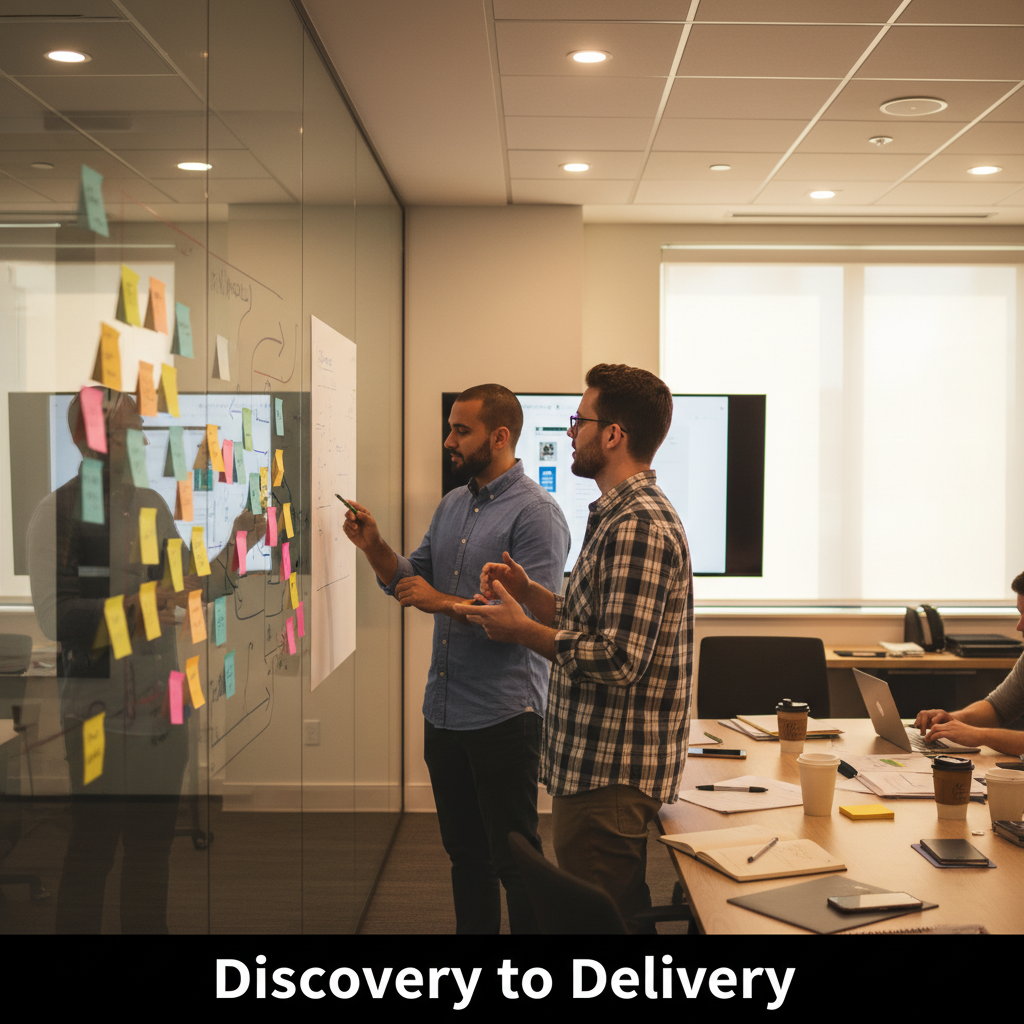Bespoke Software Development Service: A 2025 Playbook for Toronto Teams
Choosing a bespoke software development service is about aligning software to your exact workflows, compliance needs, and growth targets—without the bloat and compromises of generic tools. From our location in ON at Unit 20 – 120 Woodstream Blvd (L4L 7Z1), Codepaper Technologies Inc. helps Toronto- and Canada-based organizations ship faster, reduce technical debt, and scale with confidence.
Primary focus: bespoke software development service. Secondary focus areas: custom software development Toronto, DevOps services Canada, Laravel development services, mobile app development Toronto, website design Toronto, and data analytics services Canada.
TL;DR
If you only read one section: A bespoke software development service builds exactly what your business needs—no more, no less—so teams move faster, security risks drop, and ROI shows up sooner. Expect discovery in 1–3 weeks, an MVP in 8–16 weeks, and continuous releases through a hardened CI/CD pipeline. Use this guide to plan scope, budget, governance, and vendor selection.
Quick Answer
In ON at Unit 20 – 120 Woodstream Blvd, Codepaper delivers a bespoke software development service for regulated and fast-moving teams in Toronto and across Canada. We scope quickly, prototype early, and ship in secure sprints that integrate with your cloud, data, and mobile stack.

What Is a Bespoke Software Development Service?
“Bespoke” means the solution is purpose-built around your processes, users, data model, and compliance posture. Instead of bending your operations to fit a boxy product, a bespoke software development service molds technology to your business—streamlining handoffs, reducing rework, and unlocking value that off-the-shelf tools can’t reach.
When bespoke wins
- Complex workflows and integrations: ERP, EDI, telematics, banking rails, or multi-warehouse inventory where precision matters.
- Compliance-driven environments: PII/PHI, SOC 2, PCI-DSS, regional data residency, and auditable change management.
- Omnichannel experiences: Unified experiences across web, iOS, and Android tied to one source of truth.
- Differentiated IP: Your process is the moat—generic software can’t replicate your advantage.
When off-the-shelf is enough
- Commodity workflows: Email, basic CRM, or payroll where fit and differentiation don’t matter.
- Short-lived pilots: Throwaway prototypes, event apps, or time-bound initiatives.
- Budget-first decisions: If time-to-value outweighs precision, configure-first can be a smart bridge.
For a balanced perspective on choosing custom vs. generic tools, review this custom vs. off-the-shelf comparison that outlines trade-offs across cost, time, and maintainability.
What a Bespoke Software Development Service Includes
Our delivery model is intentionally lightweight, measurable, and transparent. It’s built to align business outcomes with engineering velocity, so stakeholders always know what’s shipping next and why.
Core phases from discovery to scale
- Discovery and framing (1–3 weeks): Stakeholder interviews, current-state mapping, KPIs, risk register, and ROI narrative. Output: north-star goals and a prioritized backlog.
- Solution architecture (1–2 weeks): Reference architecture, data model, and integration plan. Common stacks include Laravel + React, Node.js + Next.js, and cloud services on AWS/Azure/GCP.
- Secure build (ongoing): OWASP-aligned defaults, code reviews, threat modeling, and secure secrets management.
- CI/CD and quality gates: Unit, API, and UI automation; performance budgets; blue/green or canary deployments with rollback.
- Launch and observability: DORA metrics, error budgets, synthetic monitoring, and post-launch hardening sprints.

Comparison: bespoke vs. alternatives
| Option | Time to Value | Fit to Process | Total Cost of Ownership | Scalability |
|---|---|---|---|---|
| Bespoke build | Medium (MVP in 8–16 weeks) | Excellent—exact to your workflows | Medium to High upfront, lower rework later | High—built for future growth |
| Off-the-shelf | Fast | Fair—workarounds and compromises | Lower upfront, higher hidden costs from misfit | Varies—limited by vendor roadmap |
| Configure-first (hybrid) | Fast to Medium | Good—extend via APIs and custom modules | Medium, depends on customization depth | Good—watch for platform lock-in |
Want a deeper dive into budgeting? See these practical cost factors often considered by product leaders planning an MVP or a re-platform.
Costs, Timelines, and Team Models
While every scope is unique, most MVPs we deliver land in the low six figures with 8–16 week timelines for a strong first release. The variables that influence scope and spend include integration complexity, data migration effort, performance requirements, security controls, and stakeholder availability for reviews.
Key cost and timeline drivers
- Integrations: ERP, payment gateways, telematics, EDI, or legacy SOAP APIs increase effort.
- Data migration: Cleaning, mapping, and reconciling historical data to a new model.
- Security and compliance: Encryption at rest/in transit, audit logging, SSO/MFA, and evidence for SOC 2 or PCI-DSS.
- Performance envelopes: Concurrency, response time budgets, and analytics workloads.
- Change management: Training, phased rollout, and process adoption.
Flexible team models
- Dedicated product squad: End-to-end ownership with product, design, full-stack, QA, and DevOps embedded.
- Agile retainer: A stable, part-time crew for continuous iteration on a live product.
- Staff augmentation: Add specialized talent to your team for a critical phase or timeline surge.
If you’re comparing partners, explore our Toronto capability pages—our custom software development in Toronto overview and our Canada-wide custom software development company page summarize how we assemble squads and structure delivery.
Technology Choices That Stand the Test
Stack selection is about solving for speed today without boxing you in tomorrow. We often combine Laravel development services for dependable backends with React or Next.js on the front end, and cloud-native services where they reduce operational overhead without hard platform lock-in. For mobile, we support cross-platform app development or fully native routes depending on performance and UX needs.
Common patterns in our builds
- Laravel + React: Rapid delivery for data-heavy apps with robust authorization and queue workers.
- Node.js microservices: Async integrations and API gateways scaled with containers.
- Mobile: Native iOS/Android when the experience demands it; otherwise cross-platform for efficiency.
- Data and analytics: Event streams, dashboards, and machine learning hooks for decision support.
- DevOps services (Canada-aware): CI/CD pipelines, observability, autoscaling, and infrastructure as code.
Explore our local credibility across mobile and web: see how we operate as an app development company in Toronto and how we approach modern front-ends in our web development company Toronto resource.
Use Cases We See Across Toronto and Canada
Because Codepaper serves multiple industries, we bring “what works” patterns from one domain to another—without violating the uniqueness of your workflows. Examples:
- Fleet management software development: Vehicle telematics ingestion, route optimization, and maintenance alerts.
- E-commerce for construction supplies: Real-time inventory, complex pricing, and jobsite delivery logic.
- Finance and banking: Secure onboarding, transaction monitoring, and audit-ready reporting.
- Restaurant franchise management: Menu consistency, location analytics, and labor forecasting.
- Solar energy platforms: Quoting engines, installer scheduling, and monitoring dashboards.
- Manufacturing inventory software: Traceability, barcode/RFID, and vendor collaboration portals.
- Sign tracking and TAS reporting: Field validations, photos, GPS, and compliance logs.
For a narrative of our approach and culture, see our welcome article and our community recognition in Toronto.
Risk Management and Governance
Risk doesn’t disappear—it’s managed. A mature bespoke software development service surfaces risks early and surrounds delivery with practical guardrails.
Security by default
- OWASP-aligned input validation, hardened authentication, and secrets management.
- Role-based access control with least privilege and comprehensive audit logs.
- Threat modeling workshops per epic; automated dependency and container scans.
Quality gates that stick
- Unit, integration, and end-to-end tests tied to pull requests.
- Performance budgets enforced in CI; fail builds on regressions.
- Blue/green or canary releases with instant rollback and error budgets.
Delivery visibility
- Weekly demos and written notes, not just standups.
- DORA metrics (deployment frequency, lead time, change failure rate, MTTR).
- Burn-up charts across scope, value, and risk retirements.
Local Tips
- Tip 1: Onsite sessions near Woodstream Blvd are easiest if you avoid Highway 400/401 rush windows; the 407 ETR can save time for workshops.
- Tip 2: In winter, plan change windows around potential storms; many Toronto teams set temporary deployment freezes before major holidays.
- Tip 3: If your data must stay in Canada, align cloud region choices and backup policies during discovery to prevent costly rework.
Mini Case Insight: Manufacturing Inventory Modernization
A mid-market manufacturer near Toronto struggled with mismatched spreadsheets, manual re-entries, and lost parts. We ran a two-week discovery, then delivered a barcode-enabled MVP in 12 weeks—integrated with their ERP and floor scanners. Results: cycle counts cut from days to hours, stockouts down sharply, and stakeholders trusted the numbers again. This is the practical payoff of a well-run bespoke software development service.
How to Evaluate and Choose Your Partner
The right partner blends consulting clarity with engineering muscle. Use this checklist to interrogate proposals and reduce risk before you commit.
Vendor evaluation checklist
- Discovery quality: Do they propose outcomes, risks, and KPIs—or just features and hours?
- Architecture rationale: Can they explain trade-offs and how the stack avoids lock-in?
- Security stance: What concrete OWASP, SSO/MFA, and evidence practices will be used?
- Quality gates: What tests must pass for code to ship? How are rollbacks handled?
- Team continuity: Who is on your squad now vs. after kickoff? Any bench-only risk?
- References and case insights: Are they relevant to your industry and scale?
Process roles at a glance
| Role | Owns | Key Deliverables |
|---|---|---|
| Product Manager | Outcomes and roadmap | Backlog, KPIs, release notes |
| Solution Architect | System design | Reference architecture, data model, integration plan |
| Tech Lead | Engineering execution | Code reviews, velocity, risk register |
| QA Lead | Quality gates | Test plans, automation, release sign-offs |
| DevOps Engineer | Pipelines and reliability | CI/CD, monitoring, incident response |
FAQs
How long does a bespoke MVP usually take?
Most MVPs take 8–16 weeks depending on integrations, data migration, and security needs. We front-load discovery to reduce rework and run sprints with CI/CD so you see meaningful increments every 1–2 weeks.
What stacks do you recommend for enterprise-grade builds?
We pick the stack to fit the job: Laravel + React for robust data apps, Node.js microservices for async-heavy systems, and native or cross-platform for mobile. All are wrapped with DevOps services Canada teams expect: IaC, monitoring, and automated tests.
Is bespoke always better than off-the-shelf?
No. If your process is commodity and speed matters most, a configure-first approach can be ideal. When processes are differentiating or compliance-heavy, a bespoke software development service gives better long-term ROI and control.
What affects cost the most?
Integrations, data migration, and security requirements are the big drivers. Scope clarity, stakeholder availability, and performance goals also influence timeline and budget. We provide ranges and tighten them after discovery.
Can you work with our in-house team?
Absolutely. We regularly co-deliver with client engineers or augment staff to meet deadlines. Clear ownership lines and shared quality gates make the partnership smooth.
Get a Right-Sized Starting Plan
Want a concrete scope, timeline, and risk plan for your next build? Book a short discovery call. We’ll map the business case and propose a staged plan (including MVP options) you can act on immediately.
Explore our Toronto and Canada capabilities: custom software development Toronto and custom software across Canada.
Key Takeaways
- A bespoke software development service fits your process instead of forcing workarounds.
- Plan on discovery (1–3 weeks), MVP (8–16 weeks), and continuous releases through CI/CD.
- De-risk with OWASP guardrails, automated tests, and observable deployments.
- Right-size the team: dedicated squad, agile retainer, or staff augmentation.
- Use local context—Toronto traffic windows, seasonality, and Canadian data residency—to plan smoother rollouts.
